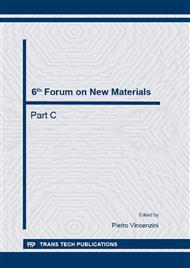p.44
p.50
p.56
p.66
p.72
p.78
p.84
p.91
p.96
Vacancy Diffusion under a Stress and Kinetic of Nanovoid Growth in Cubic Metals
Abstract:
Elastic fields, generating by defects of the structure, influence the diffusion processes. It leads to the alteration of the phase transformation kinetic. One of the chief aims of our work is to obtain general equations for the diffusion fluxes under strain that give the possibility for using these equations at low temperatures, as in this case the strain influence on the diffusion fluxes is manifested in maximal degree. Our approach takes into consideration, that the strains can alter the surrounding atom configuration near the jumping one and consequently the local magnitude of the activation barrier and a rate of atom jump. The rates of atom jumps in different directions define the flux density of the vacancies. Now we take into account, that strain values are different in the saddle point and in the rest atom position, in differ from our consideration that was done by us earlier. As a result in the development of our approach the general equations for the vacancy fluxes are obtained for fcc and bcc metals. In our paper we discuss the main features of the theory of diffusion under stress and its applications. In particular we examine how elastic stress, arising from nanovoids, influence the diffusion vacancy fluxes and the growth rate of voids in metals.
Info:
Periodical:
Pages:
72-77
Citation:
Online since:
October 2014
Authors:
Keywords:
Price:
Сopyright:
© 2014 Trans Tech Publications Ltd. All Rights Reserved
Share:
Citation:


